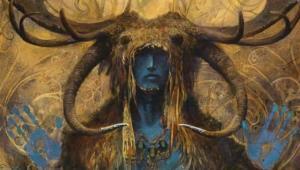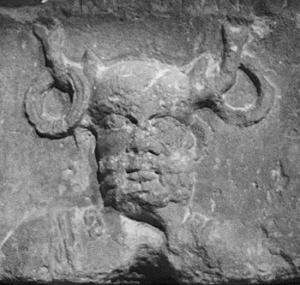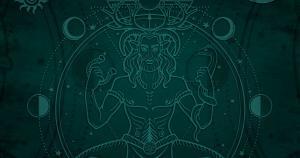Ancient mythology offers a rich tapestry of revered and worshipped deities. Among them, Cernunnos, the enigmatic Celtic god, stands out.
He is associated with nature, fertility, and the wild. He holds a legendary status that continues to captivate the curiosity of historians, anthropologists, and spiritual enthusiasts.
This blog post will delve into the mysterious origins, appearance, worship, and ancient history surrounding Cernunnos.
Exploring the Realm of Cernunnos

Cernunnos, also known as the Horned God, is prominent in Celtic mythology as a symbol of fertility, nature, and the untamed wilderness.
Originating from the ancient Celts, he was particularly revered in Gaul. Gaul was a region encompassing modern-day France, Belgium, and parts of western Germany.
The name “Cernunnos” itself has derived from a combination of the Celtic words “cern,” meaning horn, and “unnos,” representing his connection to the masculine divine.
Discovering the Origins of Cernunnos
The exact origins of Cernunnos’ cult and his name are shrouded in mystery and speculation due to the limited written records left by the ancient Celts.
However, scholars have analyzed various sources and pieced together fragments of information to offer insights into his possible origins.
One prevailing belief is that Cernunnos represents a continuation of ancient European horned deities worshipped by indigenous cultures. These horned gods were often associated with fertility, the wilderness, and the hunt.
Similar horned deities have been identified in other regions, such as the Greek god Pan and the Roman god Faunus.
The Norse god Cernunnos’ presence in Celtic art and literature further suggests a multifaceted cultural exchange and shared influences among ancient civilizations.
Some theories also suggest a connection between Cernunnos and the Indo-European influences on Celtic culture.
These influences can be seen in linguistic similarities and shared mythological motifs found across different Indo-European cultures.
Unveiling the Appearance

Cernunnos is often depicted as a deity with solid connections to the natural world and its creatures. In most artistic representations, he is portrayed as a horned figure, symbolizing his association with animals and fertility.
The antlers on his head embody wisdom, strength, and his ability to connect with and understand the natural world.
Cernunnos’ depiction frequently showcases a robust and muscular physique, emphasizing his vitality and connection to the wild.
He is often shown seated cross-legged or in a half-kneeling position, suggesting a role as a guardian or spiritual guide.
His body is often adorned with intricate patterns, spirals, and knotwork. This reflected the Celtic artistic style prevalent during that time.
In addition to his distinctive horns, Cernunnos is often depicted carrying symbolic objects that further illustrate his dominion over nature.
These objects may include a torc. This neck ring symbolizes status and power, representing his authority and influence.
He may also be shown holding a snake, representing renewal, transformation, and the cycle of life. Another common attribute is a ram-headed serpent, perhaps symbolizing his connection to animal and spiritual realms.
Additionally, the Horned God often carries a bag filled with fruits and plants, representing fertility and abundance.
Worship and Devotion
Cernunnos’ worship was prevalent among the ancient Celts, particularly in Gaul. Evidence of his cult has been found in numerous archaeological sites.
His depictions are often found in sanctuaries, on statues, and carved into stone monuments. It is believed that the Celts worshipped him as a guardian and source of fertility for their lands.
Cernunnos was revered as a deity who could bestow prosperity, protect communities from harm, and facilitate communication with animal spirits.
His worshippers recognized his power to maintain the balance and harmony between humans and the natural world.
Rituals dedicated to Cernunnos likely involved offerings of food, drink, and symbolic tokens. Rituals also included communal gatherings in sacred groves and natural spaces.
Scholars believe worship was intimately connected to agricultural and pastoral activities. He was associated with the land’s abundance, guiding crops’ fertility and the success of hunting endeavors.
Farmers sought his blessings for bountiful harvests, while hunters looked to him for success in their pursuits. The Horned God’s role as a guardian of the wild also made him a deity. He was revered by those close to nature, such as shepherds and forest dwellers.
His worship extended beyond Gaul, with evidence of his presence found in other Celtic regions, such as Britain and Ireland.
Despite variations in depiction and local mythologies, his core associations with nature, fertility, and the wild remained consistent across different Celtic cultures.
Ancient History and Significance

The ancient history of Cernunnos dates back to the Iron Age when the Celts thrived in Europe. His cult reached its height during the Gallic and Romano-Gallic periods, from the 4th century BCE to the 4th century CE.
Gaul, in particular, was a stronghold of the Horned God’s worship, with many statues and artifacts dedicated to him found in the region.
The significance extended beyond his associations with nature and fertility. He was also revered as a symbol of masculine power, vitality, and wisdom.
As a guide to both the seen and unseen realms, he embodied a connection between humanity and the divine, offering spiritual guidance and protection to his worshippers.
With the Roman conquest of Gaul, the influence of the Horned God’s cult gradually waned as the Celtic gods were assimilated into the Roman pantheon.
However, echoes of his worship can still be found in the folklore and traditions that survived the region’s transition to Christianity.
In modern times, Cernunnos has experienced a revival of interest among those seeking to reconnect with ancient Celtic spirituality.
His depiction as the Horned God resonates with individuals drawn to the sacredness of nature, the wild, and the masculine divine.
Many neo-pagan and Druidic traditions have incorporated Cernunnos into their practices. They celebrated him as a symbol of renewal, vitality, and the interconnectedness of all living beings.
Conclusion
Cernunnos, the enigmatic Celtic god, continues to intrigue and captivate our imagination with his associations with nature, fertility, and the untamed wild.
Though the exact origins of his cult remain elusive, his presence in Celtic mythology, art, and worship is undeniable. From Gaul to Britain and beyond, Cernunnos was revered as a guardian of the land, a provider of abundance, and a spiritual guide.
He is depicted as a powerful figure with antlers holding symbolic objects of authority. Cernunnos represented the harmonious relationship between humanity and the natural world.
His worship has left traces in ancient artifacts and rituals, reminding us of our ancestors’ deep reverence and connection with the land.
Today, the fascination with Cernunnos persists as modern enthusiasts seek to reconnect with Celtic spirituality and the ancient traditions of their ancestors.
Through his depiction as the Horned God, Cernunnos reminds us to honor the cycles of nature. We are also reminded to embrace our wildness and seek wisdom in the interconnectedness of all things.
We continue to explore the history and significance of Cernunnos. In doing so, we gain a deeper appreciation for the rich tapestry of ancient mythology. We also see the profound roles these deities played in the lives of our ancestors.
Fascinated by mythological gods? Check out this next article on the Emerald Tablets of Thoth here!

